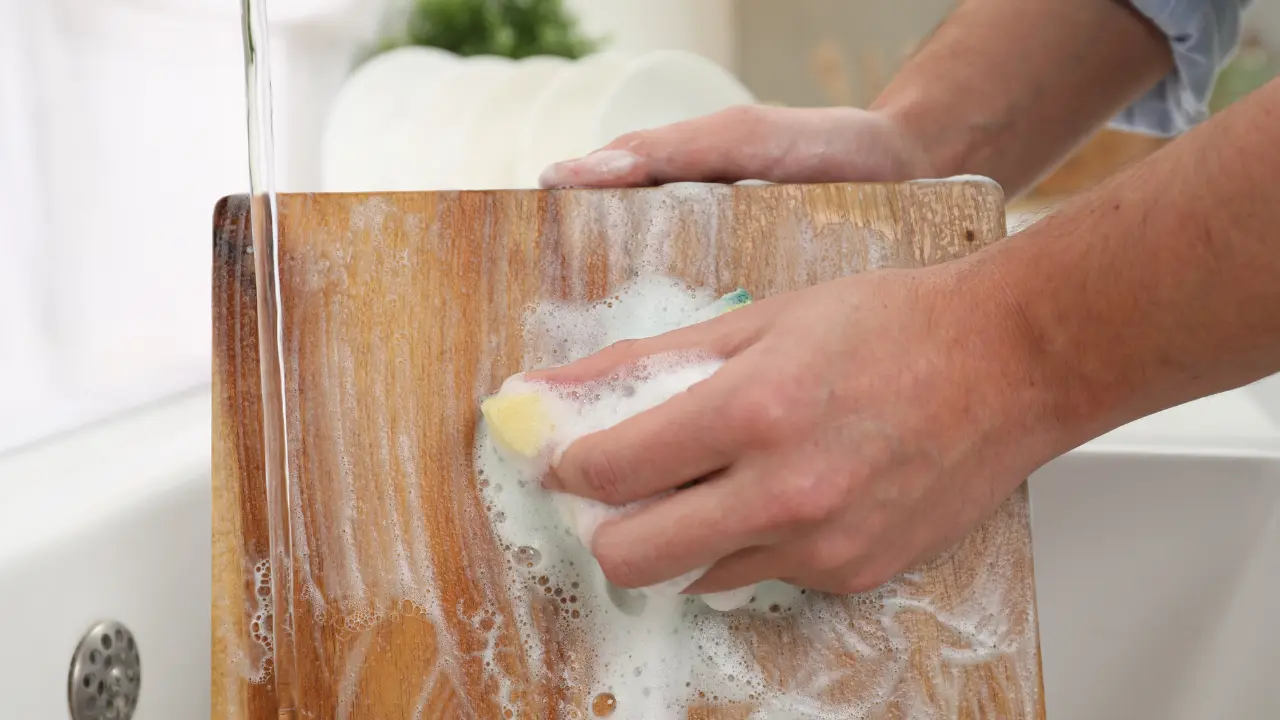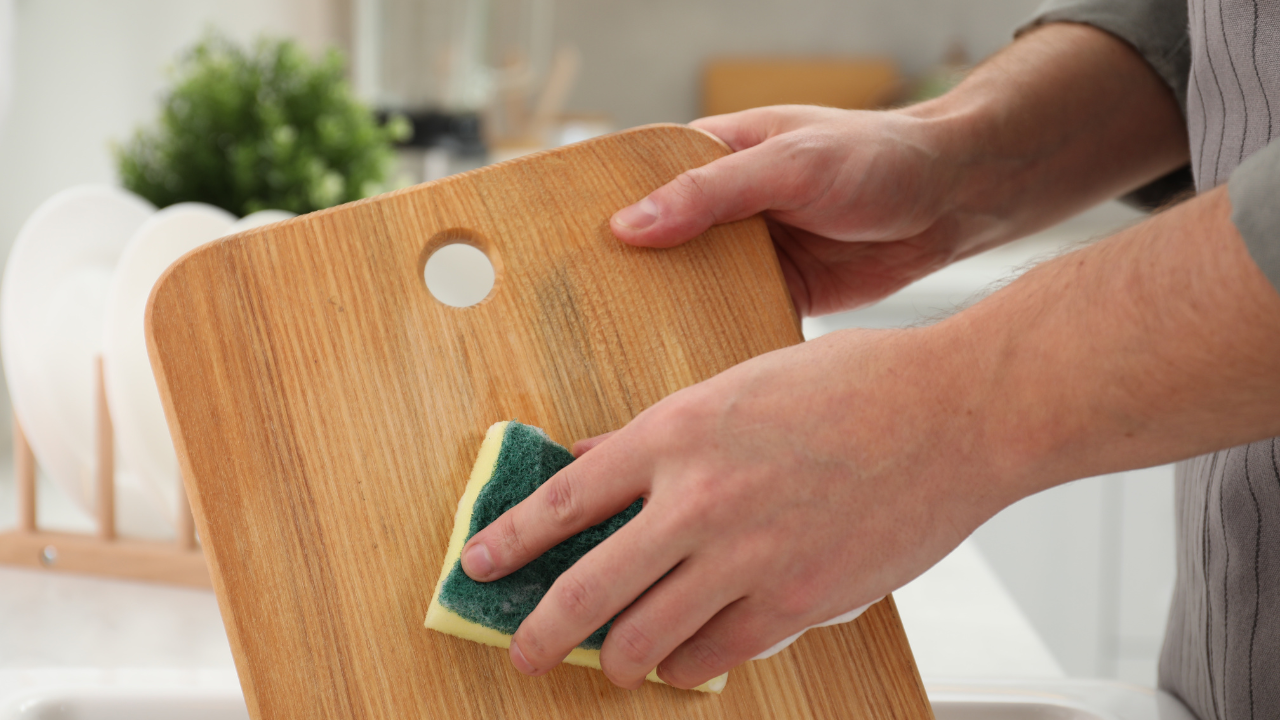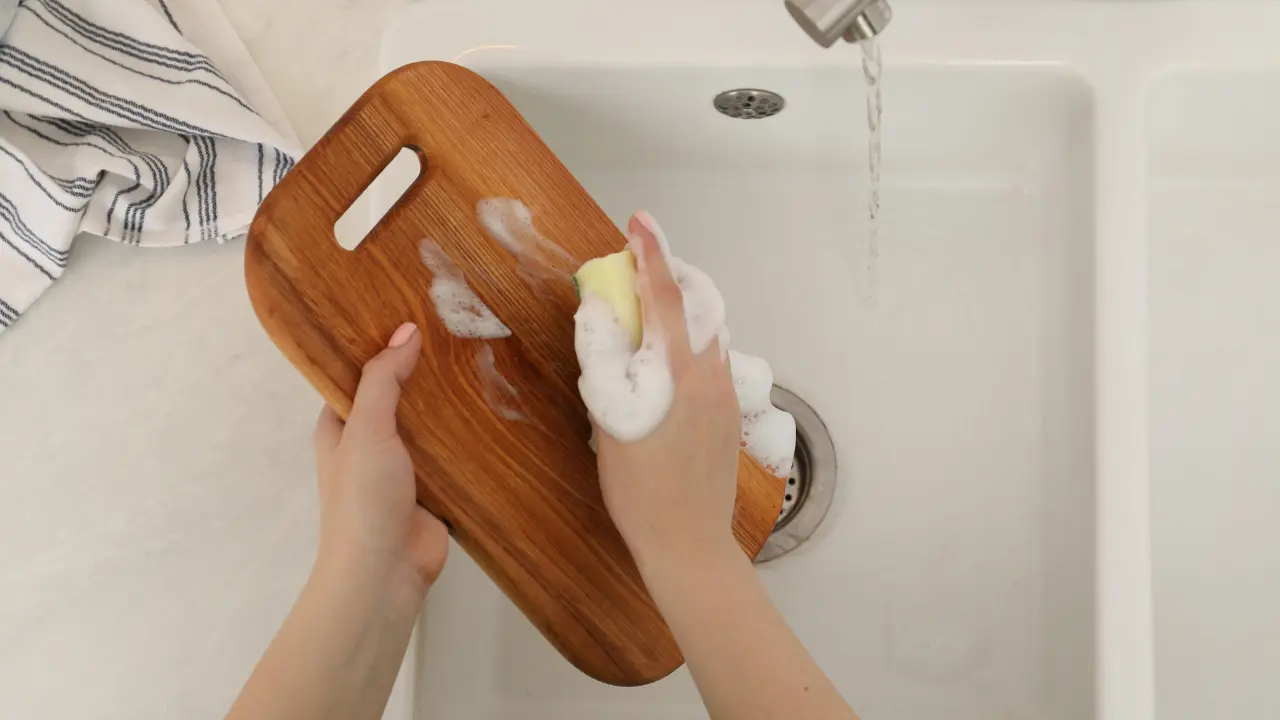Wooden cutting boards are essential kitchen tools, cherished for their durability and natural aesthetic. However, proper maintenance is crucial to ensure they remain safe for food preparation. Cleaning wooden cutting boards requires a delicate balance of effective techniques to remove stains, odors, and bacteria without compromising the wood’s integrity. In this comprehensive guide, we’ll delve into the best practices of cleaning wooden cutting boards to keep them in pristine condition for years to come.
The Daily Wash Up: Keeping Your Board Battle-Ready

After every use, your trusty cutting board deserves a quick yet thorough cleaning to prevent bacteria growth and food residue build-up. Here’s your daily cleaning routine:
-
Scrape Away the Leftovers: Before heading to the sink, use a bench scraper or a dull knife to remove any lingering food scraps. This helps prevent them from getting lodged in the wood grain and becoming harder to remove later.
-
Warm Water is Your Friend: Rinse the board under warm running water. This removes any loose food particles and prepares the board for a proper cleaning.
-
Soap Up and Scrub: Apply a few drops of mild dish soap to a clean dish sponge or a dedicated dish brush with soft bristles. Avoid abrasive scouring pads, as they can damage the wood’s surface. Scrub both sides of the board gently, paying extra attention to areas where food was prepped. The grain of the wood is your guide; scrubbing in the same direction helps prevent splintering.
-
Don’t Forget the Edges: Bacteria love to hide in nooks and crannies, so ensure you clean the sides and edges of the board thoroughly. A dedicated small brush can be helpful for these areas.
-
Rinse and Repeat (if Necessary): Rinse the board with clean water to remove all soap residue. If the board still feels greasy or has stubborn stains, repeat steps 3 and 4.
-
Air Drying is Key: Never soak your wooden cutting board! Excessive moisture can warp the wood and create cracks. Instead, stand the board upright on a drying rack to allow for air circulation. Alternatively, prop it up on its side with a clean dish towel underneath to absorb any remaining water droplets.
Deep Cleaning for Stubborn Stains and Odors
Even with daily cleaning, your cutting board may occasionally encounter particularly sticky or odorous ingredients. Here’s how to tackle those deep-seated stains and lingering smells:
-
The Power of Salt and Citrus: This natural cleaning duo is a fantastic way to remove stubborn stains and deodorize your board. Sprinkle a generous amount of coarse kosher salt over the board’s surface. Cut a lemon in half and use the cut side to scrub the salt into the wood, following the direction of the grain. The coarse salt acts as an abrasive, while the citric acid in the lemon helps lift stains and neutralize odors. Let the mixture sit for 10-15 minutes.
-
Baking Soda for Extra Cleaning Power: For tougher stains, create a paste with baking soda and a little water. Apply the paste directly to the stained area and let it sit for another 15 minutes. The baking soda acts as a gentle bleaching agent, further aiding in stain removal.
-
Scrub and Rinse: After letting the cleaning solutions sit, scrub the board thoroughly with a dish brush or a clean sponge. Rinse the board with warm water to remove all the salt, baking soda, and loosened stain particles.
-
Vinegar Rinse (Optional): For an extra layer of disinfection, you can give the board a final rinse with a diluted vinegar solution. Mix one part white vinegar with three parts water and wipe down the board. Vinegar has mild disinfectant properties but can be drying, so skip this step if your board is already feeling a bit parched.
-
Drying as Usual: Allow the board to air dry completely before storing it away. Remember, moisture is the enemy of wooden cutting boards!
Understanding Wooden Cutting Boards
Wooden cutting boards come in various types of wood, including maple, walnut, cherry, and bamboo. Each type offers unique characteristics in terms of durability, hardness, and grain pattern. Maple and bamboo are popular choices for their hardness and resistance to moisture, while walnut and cherry add a touch of elegance to the kitchen with their rich hues. Regardless of the wood type, proper cleaning is essential to maintain hygiene and prevent contamination.
Daily Maintenance
To prolong the lifespan of your wooden cutting board and ensure food safety, it’s essential to incorporate daily maintenance into your kitchen routine. After each use, rinse the cutting board with hot water to remove any food particles and debris. Use a gentle dish soap and a soft-bristled brush to scrub the surface, paying particular attention to any stubborn stains or residues. Avoid soaking the cutting board for extended periods, as excessive moisture can cause warping or cracking.
Natural Cleaning Solutions
For a deeper clean and to eliminate stubborn stains and odors, natural cleaning solutions are highly effective and eco-friendly. One popular option is a mixture of lemon and salt, which acts as a natural disinfectant and deodorizer. Simply sprinkle coarse salt over the cutting board, then rub it with half a lemon, squeezing slightly to release the juice. Allow the mixture to sit for a few minutes before rinsing with water and drying thoroughly.
Another natural cleaning solution involves using white vinegar, known for its antibacterial properties. Mix equal parts white vinegar and water in a spray bottle and spritz the solution onto the cutting board. Let it sit for a few minutes before wiping clean with a damp cloth. Vinegar helps to kill germs and bacteria while neutralizing odors, leaving your cutting board fresh and sanitized.
Removing Stains
Despite regular cleaning, wooden cutting boards may develop stains over time, especially from highly pigmented foods like berries or spices. To tackle stubborn stains, create a paste using baking soda and water and apply it to the affected area. Gently scrub the stain with a soft sponge or brush, then rinse with water. Alternatively, you can use hydrogen peroxide or diluted bleach for tougher stains, but be sure to rinse the cutting board thoroughly afterward to remove any residue.
Drying and Storing
Proper drying and storage are crucial to prevent mold and bacteria growth on wooden cutting boards. After cleaning, pat the cutting board dry with a clean towel and allow it to air dry completely in an upright position. Avoid drying the cutting board flat on the countertop, as this can trap moisture underneath and promote bacterial growth. Once dry, store the cutting board in a well-ventilated area away from direct sunlight and heat sources.
Seasoning Wooden Cutting Boards
To maintain the natural beauty and longevity of wooden cutting boards, regular seasoning is recommended. Seasoning helps to nourish the wood, prevent drying and cracking, and create a protective barrier against moisture and bacteria. Mineral oil and beeswax are popular choices for seasoning wooden cutting boards due to their food-safe properties. Apply a thin layer of mineral oil or melted beeswax to the cutting board’s surface, using a clean cloth or paper towel to spread it evenly. Let the oil or wax penetrate the wood for several hours or overnight, then wipe off any excess before using the cutting board again.
Avoiding Common Mistakes
While cleaning wooden cutting boards, it’s essential to avoid certain common mistakes that can damage the wood or compromise food safety. Never submerge wooden cutting boards in water or run them through the dishwasher, as exposure to excessive moisture can cause warping, splitting, or delamination. Additionally, avoid using harsh chemicals or abrasive cleaners that can strip the wood’s natural oils and lead to deterioration. Instead, opt for gentle cleaning methods and natural solutions to preserve the integrity of your wooden cutting board.
Summary of Clean Wooden Cutting Board
Cleaning wooden cutting boards requires a combination of gentle techniques, natural solutions, and regular maintenance to ensure optimal hygiene and longevity. By following the tips and best practices outlined in this guide, you can keep your wooden cutting board clean, sanitized, and looking beautiful for years to come. Remember to incorporate daily cleaning into your kitchen routine, remove stains with natural solutions, and season the wood regularly to maintain its integrity. With proper care, your wooden cutting board will continue to be a cherished kitchen companion for all your culinary adventures.
Read more: Custom Wood Furniture





